Nutrition, health and performance are intimately linked concepts
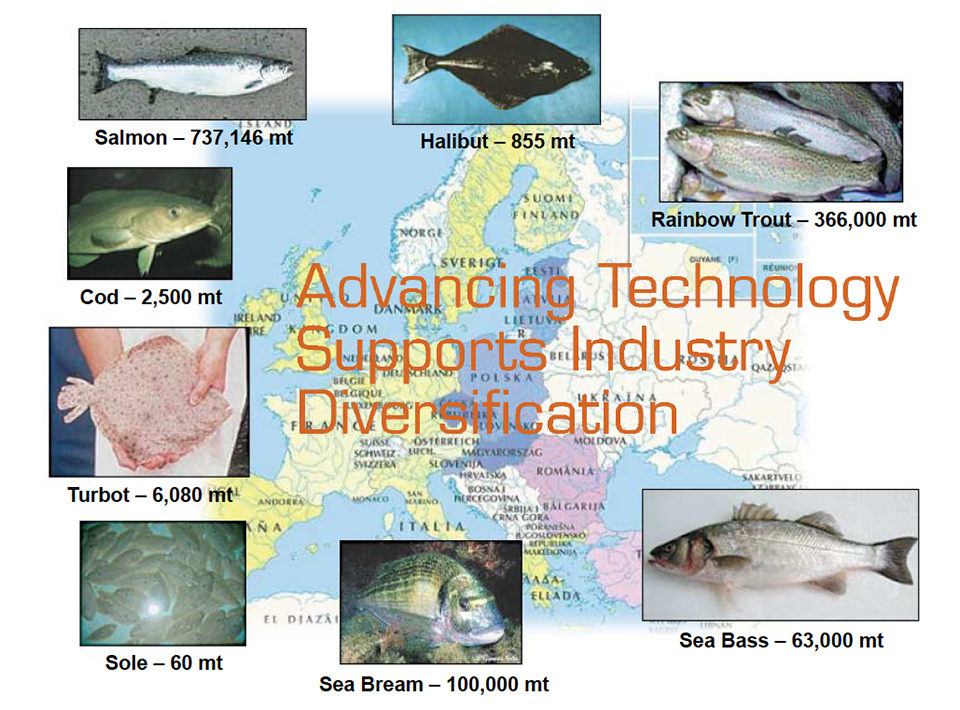
European aquaculture is still dominated by the salmon and rainbow trout industries, which contributed over 1.1 million metric tons (MT) to Europe’s 2004 finfish production. While these industries dominate the financial status of European aquaculture, the establishment and consolidation of a number of new and successful marine finfish industries from the Arctic to the southern Mediterranean regions have promoted a vibrant and rapidly growing sector.
The illustration above shows the provisional 2004 production figures for some of these more important aquaculture species. Recent advances in marine hatchery production management, technologies, and methodology have proved vital in the growth of these new industries.
Sea bass, sea bream
Sea bass and sea bream culture in the Mediterranean continues to grow, but is becoming more streamlined following consolidations, mergers, and acquisitions. Production units are more sophisticated and automated. Greater reliability of juvenile production and improvements in juvenile quality have enabled the industry to remain viable in extremely competitive market conditions.
Turbot, cod
Turbot production is gaining strength and reached over 6,000 MT in 2004, while cod production is expected to jump from 2,500 MT in 2004 to 4,000 MT this year. The development of cod production is expected to accelerate further in the next five years, offering a viable addition to the existing salmon industry, whose production levels in Europe are predicted to be fairly static for the next five years.
Larval-rearing technologies
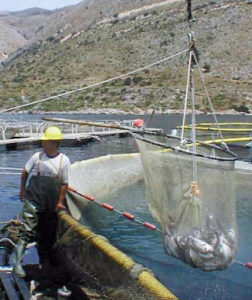
Since the 1980s, larval-rearing technologies have been continually developing for the sea bass, sea bream, and turbot industries. Figure 1 summarizes the main innovative stages and their influence on sea bream larval-rearing survivals. These criteria are also equally applicable for other marine species.
Indeed, sea bream survival rates have continued to rise since this description. Some hatcheries now report consistent survival in excess of 40 percent. Higher survival rates and improved juvenile quality are also features of sea bass and turbot production. The recently established cod industry has shown a similar developmental trend, but the gains have been greater and more quickly attained due to the core competencies already learned from the existing marine industries.
Significant changes in hatchery technology have led to increased survival and improved juvenile quality.
Improved controls
Increased concerns about biosecurity have led to a better understanding of the importance of water treatment and quality. A rash of successful borehole-supplied marine hatcheries in the Mediterranean region has enabled these units to profit from stable geothermal water temperatures, constant salinities, and the benefits of almost sterile ground water supplies. The units, however, have specific water quality characteristics due to geological origins, and careful attention has been paid to ensure correct degassing of carbon dioxide to maintain correct pH and gas saturation levels.
Hatcheries without access to geothermal water have focused on improved water treatment methods, including alternative filter media systems, ozone and UV sterilization, water maturation techniques, and recirculation. Many units for practical reasons employ a hybrid of these technologies to optimize their specific site resource availability to the cultured species.
Given secure water supplies that minimize the risk of opportunistic pathogens entering the systems, these modern hatcheries are now focusing on other technological improvements, such as vacuum degassing, automated tank-cleaning, and microparticle distribution systems designed to combat disease, increase production, and reduce costs.

Improved management
While the concept of hygiene has been discussed for many years, today successful hatcheries rigorously enforce specific hygiene policies that mirror in many ways those seen in the poultry and pig industries.
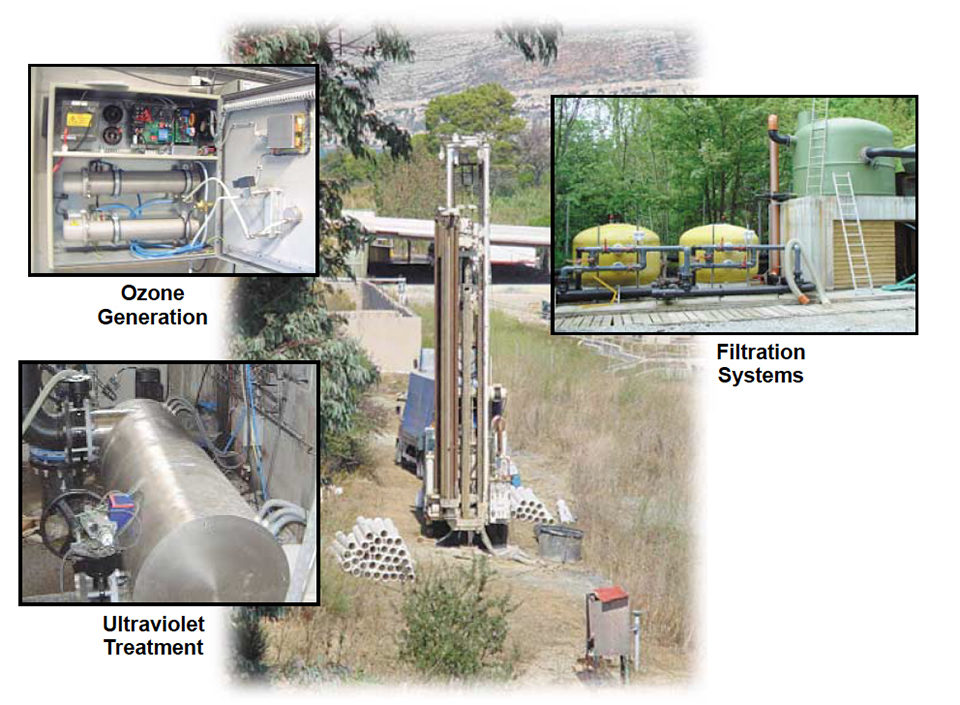
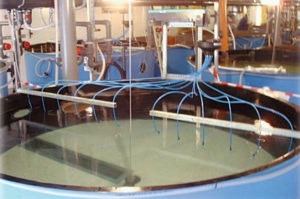
Areas within the hatchery environment are kept as discrete as possible, with minimum interaction of working personnel and equipment from one area to another. Isolated quarantine facilities are employed to prevent the introduction of disease. A number of specialized, environmentally friendly disinfecting agents are used, including foams, aerosols, sprays and recirculating systems to ensure effective pipe and systems cleaning in situ.
Production scheduling now includes specific periods when units of or whole hatcheries are shut down, cleaned and sterilized. All-in, all-out batch production provides regular sanitary control.
Nutritional developments
A more in-depth understanding of the nutritional requirements of cultured fish species has led to improvements in a number of commercially available enrichment diets for both rotifers and artemia.
The importance of the highly unsaturated fatty acids (HUFAs) – mainly eicosapentaenoic acid, docosahexaenoic acid, and the long-chain HUFA arachidonic acid – is well documented. However, improved understanding of the enzymatic development and activity in larvae and the importance of phospholipids and amino acid profiles in relation to growth and protein deposition is now a focus of ongoing improvements in enrichment and replacement diets.
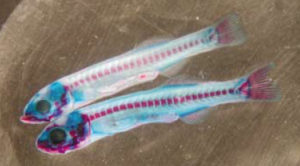
Optimized formulations for these inert diets with improved sourcing of fresh raw materials and the use of cold-extrusion spherizer agglomeration systems have been used to produce a range of highly digestible diets that are now aimed at the complete replacement of the live food chain. This work has led to the alleviation of some pigmentation and deformity problems in larval rearing, as well as improved growth performance and larval survival, and significant reductions in rotifer and artemia use.
Novel staining techniques have helped investigate skeletal formation in the early larval stages. The techniques enable the early identification of cartilage and bone structural problems, associating these abnormalities with particular periods of larval development.
It is hoped that further developments of micronized replacement diets will both simplify and standardize future marine fish larval rearing and enable a greater number of species to be commercialized. Given the restrictions of the very small mouth sizes of marine larvae such as groupers and the difficulties in maintaining extremely small strains of rotifers for first feeding, highly digestible diets of this type may provide an alternative strategy for the industry.
Tools against disease
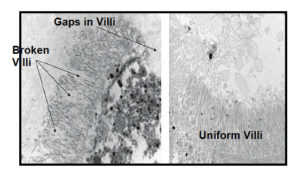
Nutrition, health and performance are intimately linked concepts. European Union legislation promotes food and feed safety issues and full tracability, and the use of pharmaceuticals is severely restricted. To meet these rigorous demands, the marine industry is looking to the development of natural solutions promoting fish health that lead to better growth and performance with reduced losses.
The development of molecular techniques for the identification and screening of pathogens offers the potential to improve disease prevention and control. The sensitivity of nucleic acid probes now enables the detection of subclinical carriers of some infections, which is an important tool for the establishment of specific pathogen-free broodstocks.
A limited number of vaccinations are registered for commercial use to protect against certain diseases. Vaccinations take places prior to transfer from the hatchery facilities to the ongrowing units. This effective control, however, depends on the ability of the fish to develop an immune response, which is only feasible after juveniles reach a certain age.
Bioavailable organic minerals and selected nutrients designed to improve immune status are also used by the aquaculture industry. Recently, through pathogen-binding capabilities and the improvement of gut microvilli structures, mannan oligosaccharides have been shown to affect the growth and survival of larval bream and lobsters, as well as offer prophylactic protection against a variety of pathogens.
(Editor’s Note: This article was originally published in the April 2005 print edition of the Global Aquaculture Advocate.)
Now that you've finished reading the article ...
… we hope you’ll consider supporting our mission to document the evolution of the global aquaculture industry and share our vast network of contributors’ expansive knowledge every week.
By becoming a Global Seafood Alliance member, you’re ensuring that all of the pre-competitive work we do through member benefits, resources and events can continue. Individual membership costs just $50 a year. GSA individual and corporate members receive complimentary access to a series of GOAL virtual events beginning in April. Join now.
Not a GSA member? Join us.
Author
Tagged With
Related Posts

Responsibility
A look at integrated multi-trophic aquaculture
In integrated multi-trophic aquaculture, farmers combine the cultivation of fed species such as finfish or shrimp with extractive seaweeds, aquatic plants and shellfish and other invertebrates that recapture organic and inorganic particulate nutrients for their growth.

Innovation & Investment
A review of unit processes in RAS systems
Since un-ionized ammonia-nitrogen and nitrite-nitrogen are toxic to most finfish, controlling their concentrations in culture tanks is a primary objective in the design of recirculating aquaculture systems.

Health & Welfare
Advances in intensive copepod production technology
Research at the Oceanic Institute has been successful in overcoming bottlenecks associated with rearing small-mouthed fish larvae by finding a suitable first feed. Early work on the calanoid copepod Parvocalanus crassirostris focused on parameters necessary for successful maintenance of stock cultures.

Health & Welfare
Advances in yellowtail larval rearing
The University of the Canary Islands in Spain is researching yellowtail broodstock management and larval rearing to promote aquaculture diversification in Europe.


